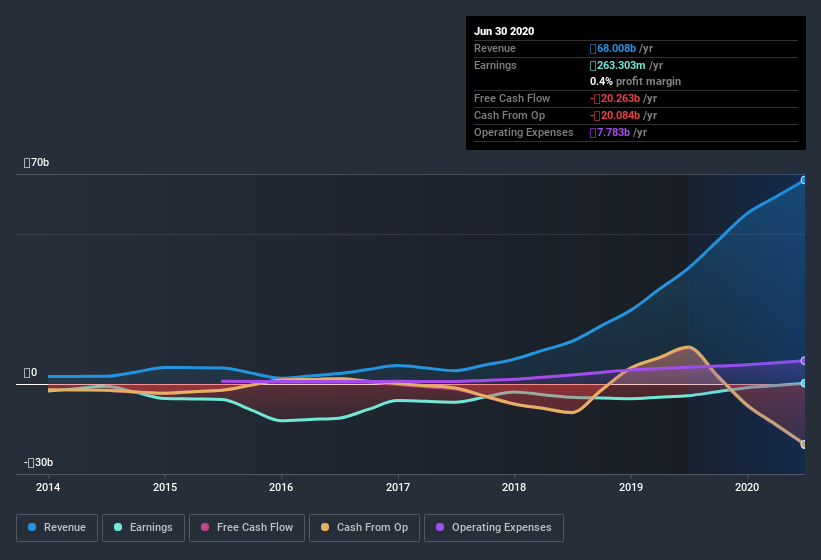- Russia
- /
- Real Estate
- /
- MISX:INGR
We're Not Counting On INGRAD (MCX:INGR) To Sustain Its Statutory Profitability
As a general rule, we think profitable companies are less risky than companies that lose money. However, sometimes companies receive a one-off boost (or reduction) to their profit, and it's not always clear whether statutory profits are a good guide, going forward. This article will consider whether INGRAD's (MCX:INGR) statutory profits are a good guide to its underlying earnings.
While INGRAD was able to generate revenue of ₽68.0b in the last twelve months, we think its profit result of ₽263.3m was more important. We know some investors love those high revenue growth stocks, but we do like to look at profit, even if it is, perhaps, a bit old fashioned. The chart below shows that revenue has improved over the last three years, and, even better, the company has moved from unprofitable to profitable.
View our latest analysis for INGRAD

Importantly, statutory profits are not always the best tool for understanding a company's true earnings power, so it's well worth examining profits in a little more detail. Today, we'll discuss INGRAD's free cashflow relative to its earnings, and consider what that tells us about the company. Note: we always recommend investors check balance sheet strength. Click here to be taken to our balance sheet analysis of INGRAD.
Zooming In On INGRAD's Earnings
Many investors haven't heard of the accrual ratio from cashflow, but it is actually a useful measure of how well a company's profit is backed up by free cash flow (FCF) during a given period. To get the accrual ratio we first subtract FCF from profit for a period, and then divide that number by the average operating assets for the period. The ratio shows us how much a company's profit exceeds its FCF.
That means a negative accrual ratio is a good thing, because it shows that the company is bringing in more free cash flow than its profit would suggest. That is not intended to imply we should worry about a positive accrual ratio, but it's worth noting where the accrual ratio is rather high. That's because some academic studies have suggested that high accruals ratios tend to lead to lower profit or less profit growth.
Over the twelve months to June 2020, INGRAD recorded an accrual ratio of 0.33. Unfortunately, that means its free cash flow was a lot less than its statutory profit, which makes us doubt the utility of profit as a guide. Over the last year it actually had negative free cash flow of ₽20b, in contrast to the aforementioned profit of ₽263.3m. It's worth noting that INGRAD generated positive FCF of ₽12b a year ago, so at least they've done it in the past. The good news for shareholders is that INGRAD's accrual ratio was much better last year, so this year's poor reading might simply be a case of a short term mismatch between profit and FCF. As a result, some shareholders may be looking for stronger cash conversion in the current year.
Our Take On INGRAD's Profit Performance
As we discussed above, we think INGRAD's earnings were not supported by free cash flow, which might concern some investors. As a result, we think it may well be the case that INGRAD's underlying earnings power is lower than its statutory profit. On the bright side, the company showed enough improvement to book a profit this year, after losing money last year. Of course, we've only just scratched the surface when it comes to analysing its earnings; one could also consider margins, forecast growth, and return on investment, among other factors. If you'd like to know more about INGRAD as a business, it's important to be aware of any risks it's facing. To that end, you should learn about the 3 warning signs we've spotted with INGRAD (including 2 which shouldn't be ignored).
This note has only looked at a single factor that sheds light on the nature of INGRAD's profit. But there are plenty of other ways to inform your opinion of a company. For example, many people consider a high return on equity as an indication of favorable business economics, while others like to 'follow the money' and search out stocks that insiders are buying. While it might take a little research on your behalf, you may find this free collection of companies boasting high return on equity, or this list of stocks that insiders are buying to be useful.
If you decide to trade INGRAD, use the lowest-cost* platform that is rated #1 Overall by Barron’s, Interactive Brokers. Trade stocks, options, futures, forex, bonds and funds on 135 markets, all from a single integrated account. Promoted
New: AI Stock Screener & Alerts
Our new AI Stock Screener scans the market every day to uncover opportunities.
• Dividend Powerhouses (3%+ Yield)
• Undervalued Small Caps with Insider Buying
• High growth Tech and AI Companies
Or build your own from over 50 metrics.
This article by Simply Wall St is general in nature. It does not constitute a recommendation to buy or sell any stock, and does not take account of your objectives, or your financial situation. We aim to bring you long-term focused analysis driven by fundamental data. Note that our analysis may not factor in the latest price-sensitive company announcements or qualitative material. Simply Wall St has no position in any stocks mentioned.
*Interactive Brokers Rated Lowest Cost Broker by StockBrokers.com Annual Online Review 2020
Have feedback on this article? Concerned about the content? Get in touch with us directly. Alternatively, email editorial-team (at) simplywallst.com.
About MISX:INGR
INGRAD
JSC OPIN, together with its subsidiaries, engages in investing in, developing, managing, and disposing real estate projects in Russia.
Acceptable track record with imperfect balance sheet.
Similar Companies
Market Insights
Community Narratives



